Southern Right Whale
Southern Right WhaleEubalaena australis | |
|---|---|
| Kingdom: | Animalia |
| Phylum: | Chordata |
| Class: | Mammalia |
| Order: | Cetacea |
| Family: | Balaenidae |
| Status | |
| World: | Least concern (IUCN) |
| Australia: | Endangered (EPBC Act) |
| Victoria: | Endangered (FFG Threatened List 2025) |
| FFG: | Listed; Action Statement No.94 |
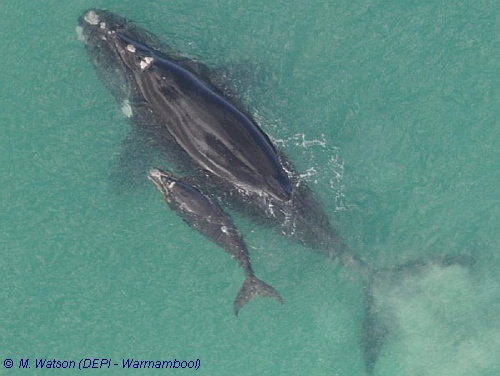
The Southern Right Whale Eubalaena australis is a species which has been brought to the brink of extinction in the first half of the 19th Century due to commercial whaling. It is the only member of the family Balaenidae in the Southern Hemisphere, although it is closely related to two northern hemisphere species (Eubalaena japonica and Eubalaena glacialis) but it is reproductively isolated by geographic separation of calving grounds and asynchronous breeding seasons.
The Southern Right Whale is one of the mysticete or baleen group of whales but does not have the pleated throat and ventral groves that are a feature of whales in the family Balaenopteridae.
The Southern Right Whale has an average length of 16m (weighing about 50 tonnes) and a distinctive, bulky blue-black or dark brown rotund body, which features obvious white markings (callosities) around the mouth, above the eyes and on top of the head. The pattern of these skin growths is unique to each animal and is used for photo identification of individual whales.
Related page: Southern Right Whale South-eastern Australia monitoring project
Distribution
The Southern Right Whale has circumpolar distribution in the Southern Hemisphere occurring between latitudes of approx. 30-60 0S, they are known to occur in coastal waters of South America, South Africa, New Zealand and some oceanic islands but populations of Southern Right Whales in Australia are genetically distinct from other southern hemisphere populations.
In Australia, Southern Right Whales are recorded along the southern coastline from Perth to Sydney including Tasmania. The National Conservation Management Plan for Southern Right Whale 2011 - 2021 recognises two genetically distinct Australian stocks, South Eastern Australian and South Western Australian..
In 2008 the entire the population which spans across the Southern Hemisphere was estimated to be 7500 with up to 2100 frequenting Australian waters (DEWHA 2007, IUCN 08). In 2012 the overall Australian Southern Right Whale population (South-west and South-east) was estimated to be 3,500 (National Conservation Management Plan for Southern Right Whale 2011 - 2021).
It was thought that the many of the populations across the Southern Hemisphere had had a general overall increase of about 7% per year but the status of the south-east Australia population (Victoria, South Australia, Tasmania and New South Wales) appears not to have exhibited the same rate of increase, placing them in a more vulnerable situation. The south‐western Australian subpopulation was estimated at 2,585 individuals in 2020 and is increasing at a rate of 6% per annum (Smith et al., 2021). The south‐eastern subpopulation is approximately 268 individuals with an overall increase of 4.7% per annum (Stamation et al., 2020).
Ecology & Habitat
Life cycle
The Southern Right Whale is thought to have about a 60 year life span. Following mating the gestation period is about 11-12 months, pregnant cows give birth to one calf (about 5.5 meters in length). The mean calving interval is 3.5 years. Lactating females fast for at least four months while providing milk for calves. Southern Right Whales are not known to feed in Australian waters, their feeding grounds are further south (40-600 S) but rarely observed near the Antarctic pack-ice. They feed primarily on copepods and post-lavae of Munida gregaria and occasionally the larger Euphausia sp. krill, but are not considered to compete against other baleen whales for food.
Movement
In Australia, Southern Right Whales have an annual migration between summer feeding grounds in the sub-antarctic waters of the Southern Ocean to more temperate inshore waters inshore waters off the coast of southern Western Australia, South Australia, Tasmania, Victoria and occasionally New South Wales.
It has been found that there is some mixing of whales from genetically distinct populations occurring on the migratory corridors. It has also been found that females belonging to one subpopulation can relocate long-term to a calving area in another region (Watson et al. 2021).
During what is termed the 'over-wintering months' (May to November) Southern Right Whales have a tendency to frequent certain coastal areas where localised aggregations occur and during this time breeding, calving and rearing of young takes place. It is estimated that 95% of the total Australian population over-winters at the head of the Great Australian Bight in South Australia.
Counter‐clockwise migration has been found to occur with whales from the south‐western subpopulation arriving on the Australian coast from summer feeding grounds in sub-antarctic waters. Movement tends to occur in a circular anti‐clockwise direction into south‐eastern Australia before traveling west to calving grounds in South Australia and Western Australia (Watson et al. 2021).
Calving, resting habitats
Through the development of marine bioregional plans, Biologically Important Areas (BIAs) have been identified for southern right whales. These are areas are important for the conservation of protected species and are considered to support biologically-important behaviours of the Southern Right Whale e.g. calving, foraging, resting or migration. Thirteen Southern Right Whale coastal aggregation areas have been identified in Australia, three of which are in Victoria (Portland, Port Fairy/Warrnambool and Port Campbell/Peterborough). The Port Fairy/Warrnambool area is identified as an established small BIA and the Portland and Port Campbell area identified as emerging BIA’s.
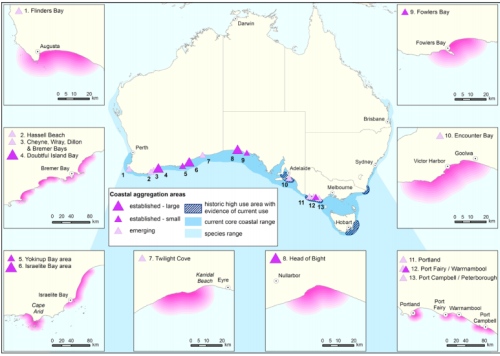
In 2028, 2021 and 2025, the Narrawong-Tyrendarra area near Portland was occupied as a nursery area and is now considered an important area for breeding females.
Logans Beach
Logans Beach in Warrnambool, Victoria is the only established calving ground in south‐east Australia with 96 calves born there between 1980 and 2021 (an average of 2.6 per year).
It could be considered the only true nursery area in Australian waters. Females show a strong fidelity for frequenting calving sites. Whales can arrive from May onwards and females with young can remain in this nursery area up until October or early November. At present it is not known why this area or other favoured areas are repeatedly chosen and what factors constitutes suitable habitat at these sites.
Threats
Southern Right Whales were hunted close to extinction; the Australian industry reached its peak in 1837 and was considered to be in a state of collapse by 1840. Continued hunting in the summer feeding grounds further reduced the population to a point where it became extremely rare and no longer commercially viable, by 1935 it was protected by an international agreement at which time the worldwide population was estimated to be only about 1000 animals.
The slow but steady recovery in recent years is promising, however a number of new threats have emerged since the cessation of whaling for this species. Threats can impact on both individual whales and to some extent the broader population as humans develop more innovative and intense ways of utilising marine ecosystems. Current threats include; noise from marine industries such as gas and oil off-shore exploration and development, entanglement in commercial fishing gear, interference in nursery areas form unmanaged eco-tourism, collision with ships, ingestion of pollutants from oil spills and marine debris such as plastics. Changes to marine ecosystems and potential impacts on the availability of suitable plankton for food may emerge as issues related to global warming.
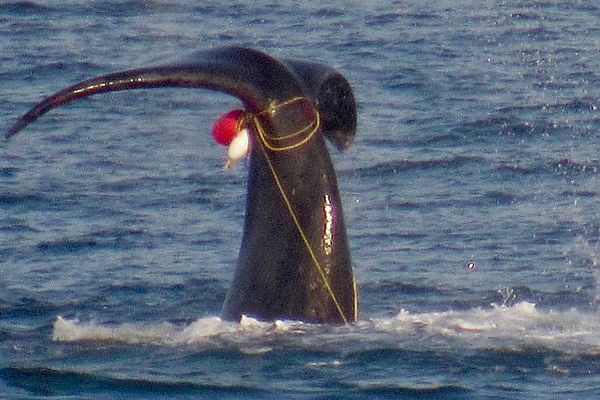
Conservation & Management
The conservation status of Southern Right Whale was re-assessed from Critically Endangered in 2013 (DSE 2013) to Endangered in 2020 as part of the Conservation Status Assessment Project – Victoria (DELWP 2020).
Genetic Research
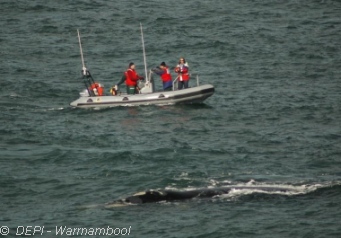
There is now evidence of significant differentiation between South Africa, South America, Australia (WA) and New Zealand haplotype and nucleotype levels (Patenaude et al 2007). Further genetic work between 2001 – 2009 involved data collection from South Eastern Australia which was coordinated by DEPI with support of state and commonwealth funding (AMMC).
Analysis of mitochondrial DNA from 56 samples from New Zealand, Western Australia, South Australia, Victoria and New South Wales found:
- Levels of genetic diversity in the South East Australian population was high and comparable with South West Australia
- There are significant difference in mt DNA between South East and South West Australia and New Zealand
- The amount of differentiation between the two Australian populations is greater than either compared with New Zealand
(Carroll et al 2011)
In 2014, further work was carried out with an expanded sample size (94 whales) which also included Tasmania. Preliminary results indicate a confirmed significant mt DNA differentiation between South East and South West populations and differences between states detected using microsat data which is being investigated further.
Photo Identification
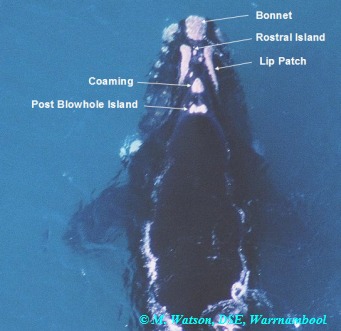
Each Southern Right Whale has its own unique pattern of white markings (callosities) covering the head area which is used for photo identification (see diagram, based on Bannister 1990). There are four major identification catalogues in Australasia, (South-east Australia, Head of Great Australian Bight, Western Australia and New Zealand). Workshops are held every two to three years at which time photos are matched to assess population size, structure and movement.
The South-eastern Southern Right Whale photo-identification catalogue was established in 2002. It is a multi-government agency project which is co-ordinated by DEPI, Warrnambool. The project is supported by Commonwealth and State based threatened species funding.
Whale identification flights are conducted opportunistically from South Australia, Victoria, Tasmania, New South Wales. Images are stored in Southeast Australia Southern Right Whale Photo Identification Catalogue (SEA SRW PIC). The project also uses the BigFish© system developed for the South Australian government. It is an Access Database with photo-ID matching facility (CodeCompare) based on a system designed in USA. The catalogue holds over 3000 images - primarily dorsal view comprising of 450 individual whales.
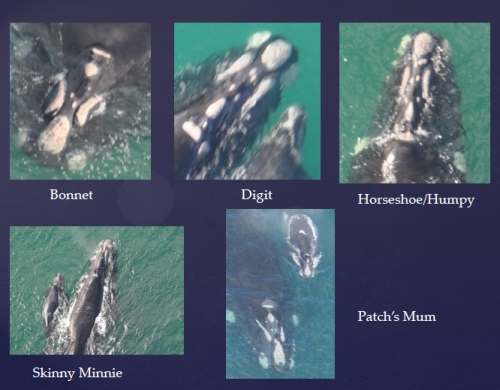
Key findings from photo ID
Source: (Watson et al. 2021)
- Between 1993 and 2018, 375 individual whales (including 48 breeding females) were identified in south-eastern Australia (east of the SA/Victorian border).
- The mean calving interval is 3.5 years.
Movement
- 7% of whales sighted in the south-eastern Australian Region were also sighted in the south-western Australian region.
- Females belonging to one subpopulation can relocate long-term to a calving area in another region. E.g., Calving female SE9901 (‘Wilma’) had shown strong calving site fidelity to Logans Beach in south‐east Australia before shifting to the Head of Bight calving ground in south‐west Australia.
- Whales from the south-western subpopulation arriving on the Australian coast from summer feeding grounds in the south, move in a circular anti-clockwise direction into south-eastern Australia before traveling west to calving grounds in SA and WA.
Logans Beach
- Between 1995 and 2018, 51 individual whales were identified at the Logans Beach calving ground at Warrnambool, 15 of these were females accompanied by a calf
- 96 calves have been born at Logans Beach between 1980 and 2021 (an average of 2.6 per year)
See more information on photo ID results; Southern Right Whale research and monitoring project
DEECA sightings database
Sightings of whales have been carried out by the DEECA at Warrnambool since 1985. Between 1985 to 2021, it is estimated that 96 calves have been born at Logans Beach, Warrnambool, an average is 2.6 per year. The most born in one year was 6 calves in 1985. Records indicate no discernible increasing trend. These results combined with the photo identification work suggests that the South-eastern population is small, isolated and therefore very vulnerable compared to other populations which have recorded a 7% increase per year.
Across Victoria, the location of whale sightings is highly variable and usually with a short residency period. The areas of highest density are Portland, Port Fairy and Warrnambool (Logans Beach), Port Campbell Peterborough.
The majority of first sightings in western Victoria1 occur in May (54%) and June (42%). The majority of last sightings in western Victoria occur in September (50%) and October (38%) but there may be an increasing trend towards October with last sightings occurring in 7 out of last 10 years in October.
The earliest sighting on record was at Portland on 22 April 2006. The latest sighting on record was also at Portland on 27 October 2010.
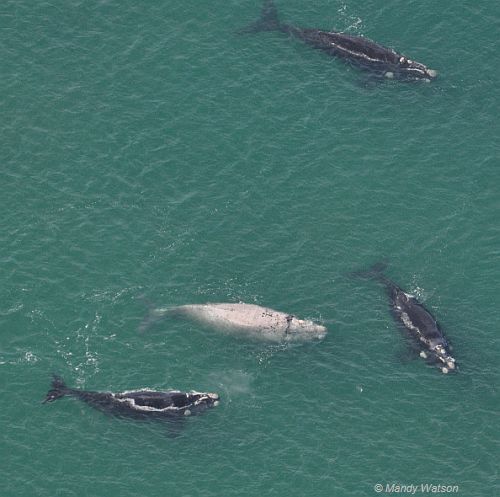
Cow and calf pairs (records 2001 - 2011)
Eastern
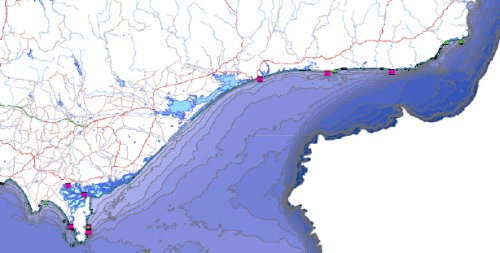
Central
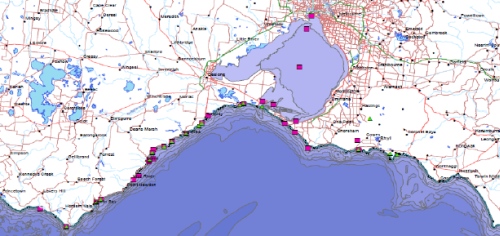
Western
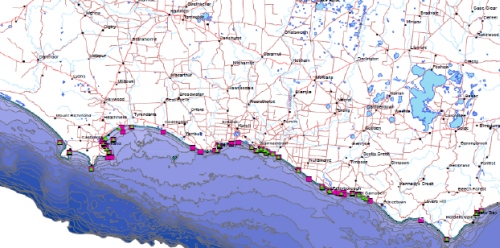
Aerial Survey
The first full population surveys of the South-east Australian region to obtain abundance estimates commenced in August 2013 and were conducted privately by Balaenidae. These surveys used the same methodology which has been used in South-west Australia since the 1970’s.
The aerial surveys involve long coastal flights conducted between Ceduna and Sydney including Tasmania over 7 days to count numbers of Southern Right Whales. A population model is based on the number of cow/calf pairs and assumes;
- each reproductive female is recorded on the coast only once in 3 years
- sex ratio of the population is 1:1
- ratio of immature to mature is 1.41:1- based on the 1998 Cape Town assessment meeting estimate (IWC, 2001)
The 2013 total population estimate was 189 (assuming same numbers of females each year for 3 years) or adjusted to 201 (assuming contiguous with WA). A 2014 survey was completed but the data has not yet been collated.
A minimum of 3 years survey is required to obtain a more accurate snapshot of population abundance.
Management Actions for conservation of the Southern Right Whale in Victoria
The Conservation Management Plan for the Southern Right Whale 2011 – 2021 states that 'conservation management for Southern Right Whales needs to be based around the existence of two populations in Australian waters with different recovery rates'. This emphasises the poor recovery of the South-eastern Southern Right Whale population and the need to do more to secure its long term future.
Research
Collaborate with national investigations into population structure and movement, including DNA sampling and photographic identification of individuals annually.
Monitoring
- Enlist the support of the wider community including fishermen in reporting of the location of whales to assist photo-id missions, monitoring and entanglement management.
- Monitor and record whale sightings at Logans Beach with particular emphasis on arrival, calving and departure dates.
- Monitor whales during season for possible entanglements with fishing gear and marine debris.
- Southern Right Whale South-eastern Australia monitoring project
Management
- Enforce the provisions of the Wildlife Act 1975 and the Wildlife (Whales) Regulations 1998 governing whale-watching activities and thus achieve greater protection from human disturbance.
- Implementation of Logans Beach exclusion zone between 1 June and 31 October each year where all vessels are banned from the area which is used for calving and rearing of juvenile whales.
- Conduct annual disentanglement training.
- Provide information to coastal shipping management to ensure it is aware of the potential for whale-ship collisions during the early winter and late spring migration seasons.
- Prepare & implement media releases at both state and local levels, to ensure that the public is informed about threats to the species. Provide and maintain up-to-date displays & interpretation material as required.
- Negotiate the incorporation of protection measures for the species in development proposals particularly off-shore oil and gas exploration.
- Develop guidelines and policy for the protection of whales from impact of noise in Victorian coastal waters, including drilling and seismic testing and development of infrastructure such as drilling platforms, pipe laying and associated shipping.
- Provision of viewing platforms at Logans Beach to facilitate land based viewing of whales.
References & Links
- Bannister, J.L. (1990). Southern Right Whales off Western Australia. Southern Right Whale aerial survey and photo-identification, southern Australia.
- Carroll, E., Patenaude, N., Alexander, A., Steel, D., Harcourt, R., Childerhouse, S., Smith, S., Bannister, J., Constantine, R., Scott Bake, C.,(2011) Population structure and individual movement of southern right whales around New Zealand and Australia Marine Ecology Progress Series Vol 432, pp 257-268.
- DELWP (2020) Provisional re-assessments of taxa as part of the Conservation Status Assessment Project – Victoria 2020, Department of Environment Land Water and Planning, Victoria. Conservation Status Assessment Project – Victoria
- DSE (2013) Advisory List of Threatened Vertebrate Fauna in Victoria – 2013. Department of Sustainability & Environment, East Melbourne, Victoria (now Department of Environment, Land, Water & Planing).
- DEH (2005), Southern Right Whale Recovery Plan 2005 –2010, Dept. Environment & Heritage, Canberra.
- DEWHA (2007), Department of the Environment, Water, Hetitage and the Arts, Species profile and threats database
- FFG Threatened List (2025) FFG Threatened List, Department of Energy, Environment and Climate Action (DEECA)
- IUCN,(2008) Red List of threatened species, species No. 8153.
- Menkhorst, P. A Field Guide to the Mammals of Australia, Oxford University Press.
- National Conservation Management Plan for Southern Right Whale 2011 - 2021) Department of Environment, Australian Government.
- Southern Right Whale, Action Statement No.94, Flora and Fauna Guarantee, Dept. Sustainability & Environment, Victoria (pdf)
- Smith J.N., Jones D., Travouillon K., Kelly N., Double M. & Bannister, J.L. (2021) Monitoring Population Dynamics of ‘Western’ Right Whales off Southern Australia 2018-2021 - Final Report on activities for 2020. Report to the National Environmental Science Program, Marine Biodiversity Hub. Western Australian Museum (lead organisation).
- Stamation, K., Watson, M., Moloney, P., Charlton, C., Bannister, J., (2020) Population estimate and rate of increase of southern right whales Eubalaena australis in southeastern Australia; Endangered Species Research: Vol. 41: 373–383, 2020. pdf
- Warneke, R.M. (1995), Southern Right Whale: In Mammals of Victoria: distribution, ecology and conservation, Ed. Menkhorst, P.W., published by Oxford University Press.
-
Watson, M., Stamation, K. Charlton, C. and Bannister, J. (2021) Calving intervals, long-range movements and site fidelity of southern right whales (Eubalaena australis) in southeastern Australia. Journal of Ceatacean Research Management 22: 17-28
More Information
- Southern Right Whale South-eastern Australia monitoring project
- Convention on International Trade in Endangered Species of Wild Flora & Fauna
- Convention of Migratory Species
- DEH guidelines for assessment approvals re seismic marine noise PDF
- International Fund for Animal Welfare defending whales
- International Whaling Commission
- National Guidelines for Cetacean Observation & Areas of Special Interest for Cetacean Observation
- Humpback Whale
| Minimum distances for approaching whales, dolphins and seals in Victoria | ||||
| Swimmer or Surfer | Recreational Vessel | Jet Ski | Aircraft | |
| Dolphin | 30 m | 100 m | 300 m | #500 m |
| Whale | 50 m | 200 m | 300 m | #500 m |
| Seal on land 30 m | ||||
Special protections zones exist at several sites along the Victorian coastline which have more stringent minimum distances regulated under the WILDLIFE (MARINE MAMMALS) REGULATIONS 2009
Note: photographs used on this page were taken under permit and with the use of high magnification telephoto lens to comply with whale watching regulations.
Summary of Southern Right Whale observations in Victoria
For 2011, 2012, 2013, 2014, 2015, 2016, 2017, 2018, 2019, 2020 and 2021 results Southern Right Whale South-eastern Australia monitoring project
Contribute your whale sightings WhaleFace
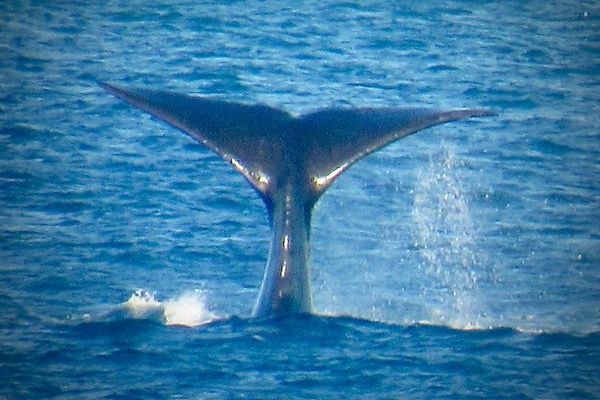
See also: Humpback Whale

